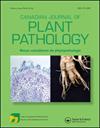Brome草是与科罗拉多州圣路易斯山谷的大麦田相关的紫锥菌接种物的主要来源
IF 1.5
4区 农林科学
Q3 PLANT SCIENCES
引用次数: 2
摘要
摘要真菌病原体紫锥菌可以感染许多草种,包括大麦、黑麦和小麦等重要作物,但很少对非作物草种的麦角病生态学进行研究。最近在美国西部的大麦生产系统中爆发的麦角病表明,附近的草宿主是接种物的宿主,并将紫锥虫传播到大麦作物中。三年来,我们调查了科罗拉多州圣路易斯山谷大麦田附近的本地、入侵和杂草物种中麦角感染的流行率。我们发现,有麦角病病史的大麦田周围有一个主要由光滑雀麦组成的草群落,光滑雀麦非常容易感染麦角病,并且在草种中感染率最高,而且草群落中的疾病严重程度在生长季节增加。在研究期间,大麦感染的发生率较低,因此无法分析未经管理的草成分和疾病发生率对田间疾病发生率的影响。我们的研究结果表明,光滑的雀麦是C.purpurea接种物的重要来源,接种物水平随着雀麦在草群落中的组成增加而增加。圣路易斯山谷的雀麦草种群中有足够的接种物,当环境条件最适合感染时,可以在大麦田中引起散发性疾病。未来的疾病管理策略应考虑到大麦生产田附近草地种群中的大量接种物。本文章由计算机程序翻译,如有差异,请以英文原文为准。
Brome grasses represent the primary source of Claviceps purpurea inoculum associated with barley fields in the San Luis Valley of Colorado
Abstract The fungal pathogen Claviceps purpurea can infect numerous grass species including important crops like barley, rye, and wheat, but the ecology of ergot disease is rarely studied in non-crop grass species. Recent outbreaks of ergot in barley production systems in the western U.S. have implicated nearby grass hosts as reservoirs for inoculum and spread of C. purpurea into the barley crop. We surveyed the prevalence of ergot infections among native, invasive, and weedy grass species near barley fields in the San Luis Valley of Colorado over three years. We found that barley fields with a history of ergot disease were surrounded by a grass community composed largely of smooth brome, that smooth brome was very susceptible to ergot infection and had the highest infection rates among grass species, and that disease severity among the grass community increased during the growing season. Over the study period there was a low incidence of barley infections and this precluded analysing the effects unmanaged grass composition and disease incidence had on within field disease incidence. Our findings indicate that smooth brome represents a significant source of C. purpurea inoculum and inoculum levels increase as the composition of brome grass in the grass community increases. There is sufficient inoculum present in the brome grass population in the San Luis Valley to cause sporadic disease in barley fields when environmental conditions are optimal for infection. Future disease management strategies should take into account the large pool of inoculum in the grass population near barley production fields.
求助全文
通过发布文献求助,成功后即可免费获取论文全文。
去求助
来源期刊
CiteScore
4.50
自引率
5.00%
发文量
56
审稿时长
6-12 weeks
期刊介绍:
Canadian Journal of Plant Pathology is an international journal which publishes the results of scientific research and other information relevant to the discipline of plant pathology as review papers, research articles, notes and disease reports. Papers may be submitted in English or French and are subject to peer review. Research articles and notes include original research that contributes to the science of plant pathology or to the practice of plant pathology, including the diagnosis, estimation, prevention, and control of plant diseases. Notes are generally shorter in length and include more concise research results. Disease reports are brief, previously unpublished accounts of diseases occurring on a new host or geographic region. Review papers include mini-reviews, descriptions of emerging technologies, and full reviews on a topic of interest to readers, including symposium papers. These papers will be highlighted in each issue of the journal and require prior discussion with the Editor-in-Chief prior to submission.

 求助内容:
求助内容: 应助结果提醒方式:
应助结果提醒方式:


